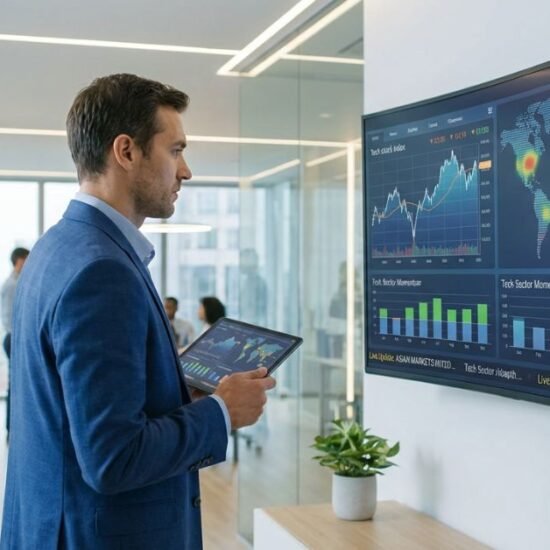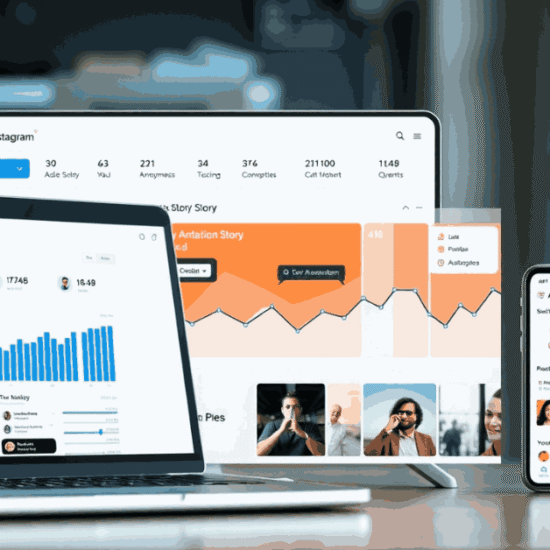Introduction
The digital landscape is evolving at a pace in 2025 that is more rapid than any other time. As real-time data demands, AI-enabled productivity and remote collaboration become the new standard, companies and creators are in search of platforms that are more than mere connectivity. Enter Mifroom, the next-generation immersive workspace that is created to support the speed, intelligence and connectivity of the next generation of the digital world.
Mifroom is not just another collaboration tool but a bridge between the physical and the virtual with smart interfaces, interactive data environments, and sophisticated spatial computing technologies. It can transform how humans approach information (and even each other) whether in enterprise innovation labs, in a hybrid classroom, or in a creative digital studio.
This paper discusses the nature of Mifroom, its functionality in the wider framework of digital innovation, its similarity to other solutions, and its rapid adoption as a staple of progressive organizations in 2025.
What Is Mifroom?
Mushroom An intelligent collaboration and spatial computing platform designed to run in next-generation digital workspaces. It is a combination of augmented reality (AR), 3D visualization, cloud processing, and AI to create dynamic and immersive environments enabling users to see data, engage with models, and work with others in real time, across devices and locations.
Mifroom is designed to fit different industries and make it possible:
- High-performance remote collaboration
- Real-time data interaction in 3D or mixed-reality spaces
- Secure cloud-based digital twins and simulations
- Advanced project co-design with integrated tools
You may be a scientist looking at simulations, an architect showing a 3D model, or a global team brainstorming product features. Mifroom can transform the experience into one that is actually collaborative and intelligent.
The Need for Immersive Digital Platforms
In 2025, businesses have been bombarded with tools to connect with teams but which do not engage them at all. Users are demanding platforms that integrate visual backdrops, real-time access, and intelligent automation—not chat and screen sharing.
Key Drivers:
- Spatial data, or 3D modeling, has become part of 46 percent of enterprise work.
- Remote teams need more than conventional slides and software mockeries.
- There is a 25-35 percent greater speed of decision-making by immersive visualization (IDC Report, 2025).
Mifroom addresses these changes with the introduction of hands-on, visually intuitive virtual environments, which allow experience-based invention and multi-user processes.
Core Technologies Behind Mifroom
The core of Mifroom is profound engineering of smart layers of technology, which are optimized regarding performance, user-friendliness, and scalability.
| Component | Function |
| Spatial Interface Engine | Powers 3D workspaces and user interaction |
| Real-Time Sync Cloud | Ensures seamless collaboration & device parity |
| Edge AI Modules | Contextual assistance and automation suggestions |
| HoloLink Integration | Embeds holographic presentations within UI |
| XR Compatibility | Enables cross-device immersive access (AR/VR) |
Mifroom can fit on any platform, whether it is a mobile application or an entirely immersive environment on an AR headset, with these modules blending virtual and physical collaboration.
Mifroom vs. Traditional Collaboration Tools
Older collaboration software (such as Zoom, Slack, or even Figma) was not designed to support spatial computing or interactable systems. With an increase in the complexity of the processes and the adoption of 3D planning in the industry, applications such as Mifroom come in to bridge the innovation divide.
Comparison: Mifroom vs Traditional Platforms
| Feature | Mifroom | Standard Tools |
| Immersive 3D Environment | ✅ Yes | ❌ No |
| Real-Time XR Integration | ✅ Yes | ❌ Limited |
| AI Deployment Interface | ✅ Yes | ❌ No |
| Life-size Model Interaction | ✅ Yes | ❌ No |
| Visual Data Layering | ✅ Yes | ❌ Basic |
Mifroom offers a 3D canvas of complex problem-solving that the flat tools do not offer, through emphasis on sensory interaction, simulation, and productivity.
How Enterprises Use Mifroom
Mushroom is already being used by forward-looking companies in several ways. It is a very powerful creator, technical, and strategic process driver due to its flexibility.
Top Industry Applications:
- Tech and R&D: Design prototypes of products and test before proceeding to the manufacturing.
- Architecture & Design: Present walk-throughs and live design sessions
- Education: Deliver STEM lessons with multi-sensory engagement.
- Medical Training: Model surgeries or anatomy demonstrations in 3D space
- Defense/Simulation: Terrain and logistics mapping defense strategies.
Live Example:
Delta Industrial Group reduced product launch prototypes by 40 percent with the help of Mifroom simulations when cross-department reviews were conducted (Annual InnovTech Report, 2025).
Mifroom’s Role in Digital Design and Engineering
To designers and engineers, tools that eliminate complexity and take models to life are of great importance. Mifroom allows more iteration, reduced back-and-forth, and improved decision-maker buy-in.
Key features include:
- Drag-and-drop model import (CAD, STEP, OBJ, STL formats)
- Multi-user editing and annotation
- Physics-enabled simulation of designs in real time
- Live streaming to non-technical stakeholders
- Voice commands and gesture support for design manipulation
These tools enable design-to-deployment processes to be quicker, more intuitive, and more user-friendly.
Integration with Artificial Intelligence
No contemporary technology platform is full of AI. Mifroom works with AI not only on performance but also to guide the user through the process smartly.
AI Capabilities in Mifroom:
- Smart scene analysis (implies zoom or rotation of the model by the viewer interaction)
- Predictive task flow suggestions
- Context-based voice command recognition
- Automatic optimization of the environment (e.g., lighting or file size optimization)
Also driven by AI are collaborative agents: bots capable of summarizing meetings, tracking requested changes, or creating follow-up schedules based on tracked activity.
Data Security, Privacy, and Compliance
Mifroom assists those organizations that operate in highly sensitive areas such as health, defense, or finance, in which case data protection must be well established.
Security Highlights:
| Standard | Supported |
| End-to-end encryption | ✅ |
| Single-tenant cloud hosting | ✅ |
| GDPR/CCPA compliance | ✅ |
| AI audit trails | ✅ |
| Role-based access control | ✅ |
Through the available options on both public cloud deployment and private cloud deployment of Mifroom, enterprises can easily be aligned to both internal policies and international standards.
Performance and Workflow Impact
According to pilot case studies, Mifroom has demonstrated quantifiable improvements in the following:
- Time-to-decision
- Project alignment speed
- Speed and rendering speeds Modeling and rendering speeds.
- Team interaction and retention
Chart: Measurable Impact After Mifroom Adoption
| Performance Metric | Before Mifroom | After Adoption |
| Design Approval Time (avg) | 15 days | 7 days |
| Meeting Engagement Rate | 63% | 91% |
| Cross-Team Revision Cycles | 5.7 | 3.1 |
| Simulation Runtime (20MB file) | 48 sec | 14 sec |
Such hard figures are easily translated into cost savings, efficiency increases, and increased employee and customer satisfaction.
The Future of Mifroom: Roadmap and Predictions
The development of machine-human interface will be the next stage of digital innovation and Mifroom is at this stage already.
Roadmap (2025–2026):
- Multilingual Voice UI Support
- Blockchain File Traceability (Digital Twin Signatures)
- Haptic Feedback Extensions
- Edge Deployment for Remote Locations
- Low/No-Code Module Builder for Citizen Developers
The analysts assume that by 2027, Miro-type platforms will enable more than three-quarters of all digital collaboration in hybrid teams and immersive task systems worldwide (Gartner Emerging Tech Forecast, June 2025).
FAQs
Is Mifroom a VR-only tool?
No. It is cross-AR, web, mobile, desktop, and headset.
Does it work with such tools as Figma or AutoCAD?
Yes, Mifroom is compatible with multi-layered model imports of many design systems.
Is Mifroom an appropriate school?
Absolutely. It is applied in STEM programs and online education around the world.
Does it require special hardware?
No. It spans from low-spec laptops to high-end XR devices.
Is it secure enough in finance or health care?
Yes. It endorses corporate-grade encryption, adherence, and authorization.
Conclusion
Mifroom heralds a great change of the way we deal with information. It is not merely software, it is a dynamic, intelligent space that turns the collaboration process into a multisensory, efficient and secure experience.
You are a product designer and need to conceive a new product, you are a remote instructor teaching a course at a university, or you are visualizing data models using artificial intelligence. Mifroom adds unparalleled depth and reality to digital work.
Visit the rest of the site for more interesting and useful articles.




